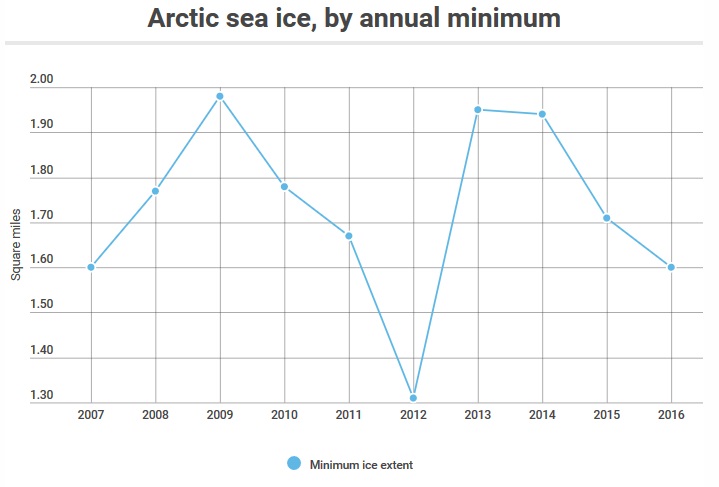Something Frightening Is Happening to the Ice Cap up North
By:
Something terrible is happening in the Arctic: Ice levels at the North Pole have shrunk to their second-lowest levels ever.
And, according to scientists, it will probably get worse.
Every year, the Arctic ice cap naturally shrinks during the spring and the summer and regenerates during the winter.
Normally, a hotter summer globally will mean a faster and more extensive ice melt; a cooler summer will mean the opposite.
This summer's weather was cool, and it should have slowed ice loss in the Arctic. But it didn't, a new study found.
Melting of the Arctic ice cap at the North Pole started in May this year — earlier than it had in 73 years, according to data from the National Oceanic and Atmospheric Administration.
Veteran Arctic biologist George Divoky described the situation as a "train wreck you can't look away from."
What's happened has surprised scientists.
"It was a stormy, cloudy and fairly cool summer," said Mark Serreze, director of the U.S. National Snow and Ice Data Center. "Historically, such weather conditions slow down the summer ice loss, but we still got down to essentially a tie for second lowest on the satellite record."
In previous years, favorable weather conditions slowed the melt. This year, ice levels fell to the low level on Sept. 10: only 1.6 million square miles. (For comparison, the lowest recorded ice level ever was 1.31 million square miles in September 2012.)
 NASA and NSIDC - cnn.com
NASA and NSIDC - cnn.com
Scientists aren't yet certain why this year was so bad, given that global summer temperatures were cooler. But they believe it may have something to do with the thickness of the ice at the start of the melt season. Thin ice takes less energy to melt and is more likely to disappear during the summer.
There was a lot of thin ice at the beginning of this year's melt season, according to researchers at NSIDC.
What should have been a better year ended up being near the worst. This isn't good.
How bad is it? So bad that we may see ice-free summers in the Arctic by the end of the century.
The North Pole currently loses about 30,000 square miles of sea ice each year, according to NASA. That's a lot of ice: an area roughly the size of the state of Maine. And since ice levels aren't rebounding to their previous levels during the winter, things are likely to get worse.
"It really suggests that, in the next few years, with more typical warmer conditions, we will see some very dramatic loses," NSIDC lead scientist Ted Scambos said.
That's frightening news for our planet's ability to regulate its temperature.
Arctic sea ice plays an important function in maintaining our climate by reflecting solar radiation back into space.
With less sea ice, the oceans warm, resulting in climate change and more ice loss. Extra heat in the upper ocean from this cycle is another possible factor contributing to the faster-than-expected Arctic ice melt this year, despite cooler summer temperatures.
Marine glaciologist Jane Lieser explained:
"We still have some sea ice, [but] to say that it is where it used to be is saying you can serve a cup of tea in a broken cup. If the cup's broken, the shards of the cup are still there, but you can't serve tea in it, can you? With sea ice, it's comparable. It's broken. It's thinner than it used to be, and it doesn't serve the climate purpose it has for centuries."
